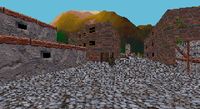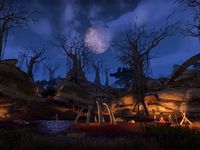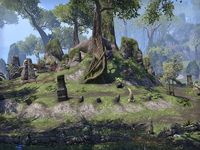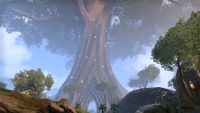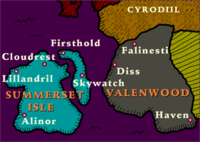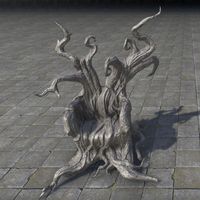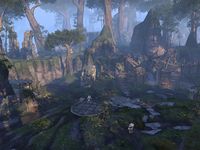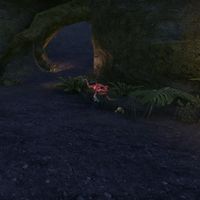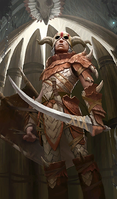Lore:Falinesti
| Falinesti | |
|---|---|
| Type | Settlement |
| Continent | Tamriel |
| Province | Valenwood |
| Appears in | Arena, ESO |
|
Falinesti is one of the eight major cities in the province of Valenwood, typically depicted on maps in the northwest portion of the province.[1] Colloquially known as the "walking city", Falinesti is historically the capital of Valenwood and the seat of power for the Camoran Dynasty, a powerful clan of Bosmer that united every tribe and ushered the First Era.[2][3] Falinesti is one of two cities built from the Elden Tree, the larger sub-species of the already tall graht-oak trees of Valenwood.[4]
Layout and Geography[edit]
"At a lesser scale, the tree that formed the moving city would have been extraordinary: gnarled and twisted with a gorgeous crown of gold and green, dripping with vines and shining with sap."
"At a mile tall and half as wide, it was the most magnificent thing Scotti had ever seen. If he had not been a starving man with the soul of a clerk, he would have sung."—Excerpt from "A Dance in Fire", written by Waughin Jarth
Falinesti is one of two cities in Valenwood built from the Elden Tree, the giant subspecies of the graht-oak.[4] Since Wood Elves rarely leave the trees and throw their trash down from the canopies,[UOL 1] garbage like broken glass and bones will litter the Falinesti forest floor.[5] Across the base of the tree is an intricate network of platforms, held together by thick vines and operated by ferrymen. They transport people across the city, from the ground floor to other districts across Falinesti.[5] According to one source, Falinesti has a port despite its seasonal sites, and it was one of the most significant stops in southwest Tamriel.[6]
One of these districts is called Havel Slump, located in the lower boughs of the tree. The streets are narrow but solid, as the book, "A Dance in Fire" explains, like the marble of the Imperial City. Curled webs of moss hang unevenly over the streets, forming a shared roof for several dozen small buildings. There is a sub-section of Havel Slump called the Western Cross and it is where hoarvor lurk. Archers are sometimes sent to exterminate them.[5] Falinesti is neighbored by several settlements, including Black Park to the south, Emperors Run to the west-southwest, and Vulkwasten Wood to the east.[1]
Notable Locales[edit]
Districts[edit]
|
|
Seasonal Sites[edit]
Falinesti's seasonal sites are found across the four regions in Valenwood. The Winter Site is located in Grahtwood, between Elden Root to the east and Gil-Var-Delle to the west. Underneath it is a vast Ayleid ruin now known as Nairume's Prison and it used to house the immortal Lady Nairume, a noble from Falinesti that caught the fancy of Rajhin's Shadow in the First Era. She was bound to the ruins by an artifact called Rajhin's Mantle and would only be freed if she fell for Rajhin.[8] The Autumn Site is located on the western bank of the Crescent River, across from the border-town, Rawl'kha in Reaper's March. The basin is connected to a vast system of caves call the Halls of Ichor and in the deepest recesses is a buried temple dedicated to Mephala.[9]
The Summer Site is located in a mountain valley in western Malabal Tor, southwest of Dra'bul and far east of Velyn Harbor. As it traveled north, the walking city ran along the Cape of the Blue Divide[2] and from there, the Dragon's Teeth Mountains were visible to the north.[7] Along the rim of the crater is large, winding caves that descended and downward, and in an attempt to bring the walking city back, the Altmer mage, Farandare built standing stones in the center of the basin to channel Oblivion, leaving cracks between the two realms.[10][11] The Spring Site is located on the north side of Greenshade's central mountain range, specifically northwest of Marbruk. For a time in the mid-Second Era, the Spring Site was occupied by the Lhurgash Clan of Wood Orcs, even though they generally respected the sites and avoid them.[12]
History[edit]
Early History[edit]
The Elden Tree that served as the basis of the settlement is one of the many graht-oaks trees known collectively as the Green-Sap, which grew from the Perchance Acorn.[13] Some sources suggest that the Elden Tree was the original one, which every other tree derives from.[4] The cityscape was designed by the legendary group of greenspeakers called the Falinesti, who were not content with making typical villages and wanted to create the ultimate fusion of city and forest.[14]
In ancient times, there were giant creatures that aimlessly roamed all of Nirn and left destruction in their wake. They decided to exile themselves to forlorn corners of the world, to prevent further devastation and fade into obscurity, except for one named Dringoth who is now remembered as the Destroyer by those that survived his passing.[15][16]
The Wood Elves of Falinesti, victims of his actions, invited the Destroyer to join them on the city's migration so that they could put him to rest forever. He finally fell asleep when Falinesti rooted in the winter and they decided to bury his bones northeast of modern-day Southpoint in an orchard called Arborfell. There they planted a seed in his skull and it grew into a massive tree called the Barrowbough. The Wood Elves also buried other members of the giant race in the orchard, interring them with shrines to Y'ffre, which not only immortalized them but also prevented their deaths. Those spirits continue to exist in the orchard, now known as the Bone Orchard.[15][16]
At some point in time, Falinesti became the seat of power for the Camoran Dynasty,[2] which was founded by King Eplear at the beginning of the First Era.[3] When the Thrassian Plague began to spread in 1E 2200, it first appeared in ports throughout southwest Tamriel and Falinesti's docks was the point of entry for the plague in Valenwood.[17] After the province's decline from the disease and constant assault from the Colovians, Valenwood ceded to the Second Empire of Cyrodiil in 1E 2714. The Camoran Dynasty continued as an entity but power had been shifted to the treethanes that formerly served the dynasty and their domains. Falinesti was one of six major countries that elevated from a local trading post to a massive power in its own right, and over time, developed culturally into something unique.[3]
Disappearance in the mid-Second Era[edit]
- For information on each specific site, see the following articles for the Autumn, Spring, Summer, and Winter Sites.
At some point in early-mid Second Era, Falinesti had disappeared and left no signs of its whereabouts. The Master of Incunabula, Andewen dated its disappearance sometime around 2E 382 and 432,[14] during Savirien-Chorak's reign over the Second Empire or very early in the Interregnum.[18][19] Many rumors and theories popped up over its disappearance, ranging from the "Daedric Interference Conjecture", the "Temporal Leap Corollary", and the "Chicken Nonconformity Detonation", the latter of which was widely popular by 2E 582.[20] A movement gathered to worship and tend to the city's seasonal sites called the Falinesti Faithful, and their goal was to preserve them for the city's return[12] while walking its usual route throughout the seasons.[21] At some point in time, the Camoran Dynasty moved from Falinesti and established their seat of power in Elden Root.[22]
The city's disappearance not only attracted the Falinesti Faithful to its site but scholars and mages were also drawn to the anomaly. Telenger the Artificer; Archmage of the Mages Guild in Skywatch[23] brought an expedition team to the Autumn Site to study it and eventually discovered the subterranean temple of Mephala, deep in the Halls of Ichor.[24] The Altmer mage, Farandare went to the Summer Site when she believed that the city was lost in Oblivion. Her husband was one of many people in Falinesti when it disappeared, and so she spent the rest of her life trying to bring the city back.[10] At around the same time, the Jade Dragoons, a high-profile militia of the Aldmeri Dominion visited the Winter Site to recover Rajhin's Mantle from the ruins. Their leader, General Endare died in her quest to retrieve it but Nairume's spirit was released from her prison.[25]
Falinesti's return and the Third Empire[edit]
By the late Second Era, Falinesti had returned and continued its cycle across Valenwood. In 2E 830, heirs of the Camoran Dynasty vied for control of the throne and it came down to two claimants. One faction made overtures of peace with one of their ancient enemies, the Colovian West by ceding territories to them in exchange for the support of their claimant, however another faction, the Altmer of the Summerset Isles invaded Valenwood and established a provisional government, the Thalmor on behalf of their own claimant, Camoran Anaxemes. Other heirs were silenced and Anaxemes, now the leader of Falinesti swore fealty to the then High King of Alinor for fifty years.[2][nb 1]
After the Third Empire overwhelmed the Aldmeri Dominion and ushered the Third Era, Emperor Tiber Septim allowed Valenwood to keep some semblance of its independence, such as its tribal councils and the Camoran figurehead.[3] Falinesti was elected as the province's capital[26] and the dynasty continued its rule in peace.[3] During Cephorus II's reign, two heirs to the throne, Haymon and Kaltos competed for the crown yet the former was able to come out on top. Haymon Camoran is remembered in history as the Camoran Usurper,[27] who conquered all of Valenwood before he took over Colovia and Hammerfell.[3] Despite Kaltos' best efforts, he could not stop him and fled Valenwood.[27] The Usurper was defeated in the Iliac Bay at the Battle of Firewaves.[28]
During the Imperial Simulacrum in the late Third Era, the city-state of Falinesti was an active settlement. It was ruled by King Elisgorn and had a rivalry with Silvenar.[7] In the twilight years of the Third Era, Falinesti had finally rooted itself for the first time in recorded history but it is currently unknown which site it landed. This event came at a distinct time for Valenwood, among other distinct events such as the first Wild Hunt in years or the appearance of a prophet called the Precursor. It has left the Imperial Geographic Society to speculate if these were signs of great change to the province or not.[3] Prior to the Great War, which started in 4E 170, there was a critical operation conducted by the Blades called the "Falinesti Incident". The Thalmor believed that the Blades loremaster, Esbern played a major role in the event.[29] At some point, a family of traitors were rumored to have perished in a fire, but one member escaped and fled to Skyrim, eventually becoming an asset to the Blades. [30]
Known Rulers[edit]
- For more information on the Camoran Dynasty, see the following article: Camoran Dynasty
As stated before, Falinesti is the capital of Valenwood[26] and is typically the seat of power for the Camoran Dynasty. They lived in the highest branches of the Elden Tree.[2][31] The dynasty created four different antler crowns for their ruling monarch, one for each seasonal site.[32] When the Second Empire assumed control of Valenwood, the dynasty lost significant power, which was then passed on to their treethanes, who ruled independent powers including Falinesti.[3]
In the mid-Second Era, Falinesti disappeared and the Camoran monarchy lived in Elden Root[22] but by the late Second Era, it returned with Camoran Anaxemes pledging loyalty to the Second Aldmeri Dominion.[2] Finally when Tiber Septim assumed control, semblances of the province's independence remained, as well as a Camoran figurehead.[3]
- The Second Era
- King Camoran Anaxemes (2E 830 – 2E ?)[2]
- The Third Era
Culture and Society[edit]
Beyond the Wood Elves, many different races local to the province live in Falinesti, specifically the Imga, the Wood Orcs,[3] and to a lesser extent, Centaurs.[5] Through Eric of Guis' stay during Falinesti's summer migration, the Second Empire and later the Third Empire were given some insight on the Bosmer people, even if it had some biases.[2]
The locals of Havel Slump celebrate every morndas with revelry but only on occasion. They celebrate on a large platform, big enough like a city plaza so everyone can dance in large clusters. They would serve the roasted carcass of a large animal and serve jagga, fermented pig's milk. Drunks would sometimes find themselves in Western Cross and be feasted on by hoarvor.[5]
Throughout the Elden Tree are small arboreal rodents called the Kollopi that only feed on the most tender branches. They are served as a simple peasant dish, little balls of flesh thick with spices and juice. They are harvested annually and because they live on the slenderest branches, only the local Imga can extract them.[33] The Falinesti Peeper is a rare type of red frog that the Brackenleaf's Briars consume to engage in a spiritual journey through the forest.[34]
Many years ago, the Striped Fawn of Clearspring Tarn, a clearing in the southeast mountains of Skyrim migrated far south and found haven among the Wood Elves of Falinesti. And although they can be spotted anywhere, they retained their original name.[35] Over time, they became Totem Elk and later vanished after the Battle of Falinesti in Reaper's March. Years later, they were rediscovered by the Falinesti Faithful and given to their most devout members.[36]
The Rooting Ceremony, when the city stops its migration is a celebrated event among the people. The time in which Falinesti travels from the summer site to the autumn site varies, from a few days, to weeks or more.[37] The Greenspeakers of Falinesti make magical thrones from ancient hardwood called Branch of Falinesti. They subtly conform to anyone that sits in them and are strangely comfortable despite the material.[38] Falinesti's disappearance made items associated with it valuable as many people sold counterfeit branches of the tree.[39]
The Twig-of-Falinesti, a stick tied to a silken strand is said to be a compass to Falinesti but when it disappeared, the twig would spin uncertainly. There was a casual board game released at the time called "Where's Falinesti?", which uses turquoise pieces.[40] After the Planemeld broke out and the subsequent Alliance War took place, the Imga were noticeably not present throughout Valenwood. The Altmer scholar, Cirantille believed that the Imga had "gone to Falinesti" to wait out the conflict.[41]
Gallery[edit]
-
Falinesti Reaver (Legends)
Notes[edit]
- Prior to Online's release, sources such as the 1st Edition of the Pocket Guide and the book series, "A Dance in Fire" claim that Falinesti rooted down south in the summer and in the north, it rooted during the winter.[2][5] However, these were later reversed in ESO.
- Arena was originally conceived as a fighting game featuring a tournament that took the player to each of Tamriel's cities to challenge different gladiatorial teams. According to a file from that stage of development left behind in the final game, Falinesti's gladiatorial team would have been called "the Wyverns".[UOL 2]
See Also[edit]
- For game-specific information, see the Arena and Elder Scrolls Online articles.
- For game-specific information on each seasonal site in Online, see the Autumn, Spring, Summer and Winter articles.
Books[edit]
- Battle of Falinesti — A brief account on the aftermath of the battle of Sphinxmoth and the fate of commander Eagle Eye
- The Collected Theory Hypothesis — On the Collective Consciousness Theorem as an explanation for the disappearance of Falinesti
- Nirwaen's Diary by Nirwaen — A journal recording the seasonal migration of Falinesti
References[edit]
- ^ a b Map of Valenwood – The Elder Scrolls: Arena
- ^ a b c d e f g h i j Pocket Guide to the Empire, 1st Edition: Aldmeri Dominion — Imperial Geographical Society, 2E 864
- ^ a b c d e f g h i j k Pocket Guide to the Empire, 3rd Edition: The Wilds Remain: Valenwood — Imperial Geographical Society, 3E 432
- ^ a b c Falinesti Autumn Site loading screen text in ESO
- ^ a b c d e f g h i j A Dance in Fire, Chapter 2 — Waughin Jarth
- ^ a b History of House Dufort — Kaera Metrick, House Historian and Chronicler
- ^ a b c d Falinesti location and rumors in Arena
- ^ Nairume's dialogue in ESO
- ^ Falinesti Autumn Site location in ESO
- ^ a b Farandare's dialogue in ESO
- ^ Farandare's Journal — Farandare
- ^ a b Egannor's dialogue in ESO
- ^ Aurbic Enigma 4: The Elden Tree — Beredalmo the Signifier
- ^ a b Andewen's dialogue in ESO
- ^ a b Last of the Old Bones
- ^ a b Olphras' dialogue in ESO
- ^ 1. The Thrassian Plague
- ^ History of the Fighters Guild
- ^ The Brothers of Darkness — Pellarne Assi
- ^ The Collected Theory Hypothesis
- ^ Tharuin the Melancholy's dialogue in ESO
- ^ a b Regring's dialogue in ESO
- ^ Neetra's dialogue in ESO
- ^ The Arbordawn Cult quest in ESO
- ^ A Lasting Winter story quest in ESO
- ^ a b Map of Tamriel – The Elder Scrolls III: Morrowind
- ^ a b The Refugees — Geros Albreigh
- ^ The Fall of the Usurper — Palaux Illthre
- ^ Thalmor Dossier: Esbern
- ^ Skyrim: J'datharr's Note
- ^ Nilenarth's dialogue in ESO
- ^ Shattered Camoran Antler Crown antiquity codex entries in ESO: Greymoor
- ^ The Red Kitchen Reader — Simocles Quo
- ^ Glaras' dialogue in ESO
- ^ Clearspring Striped Fawn pet description in ESO
- ^ Falinesti's Faithful Totem Elk mount description in ESO
- ^ Nirwaen's Diary — Nirwaen
- ^ Branch of Falinesti furnishing description text in ESO
- ^ Branch of Falinesti contraband text in ESO
- ^ "Where's Falinesti?" Boardgame contraband text in ESO
- ^ Lady Clarisse Laurent Answers Your Questions — Lady Clarisse Laurent and Stibbons
- ^ Pocket Guide to the Empire, 1st Edition: Preface — Imperial Geographical Society, 2E 864
Note: The following references are considered to be unofficial sources. They are included to round off this article and may not be authoritative or conclusive.
- ^ The Dreadful Theft of the Sun's Dusk Ale — Rascien Wickersly
- ^ Original TES: Arena texts at the Imperial Library
